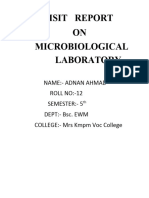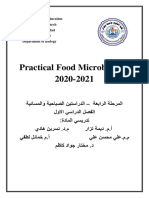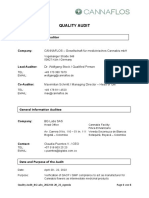Bacteria Test Guidelines: Methods For Bacteria Testing
Uploaded by
carlosBacteria Test Guidelines: Methods For Bacteria Testing
Uploaded by
carlosBacteria Test Guidelines
Bacteria Test Guidelines DOC316.53.01188
All tests for bacteria use a nutritional broth or agar and incubation at a specific temperature to grow
the target organism. Sterile equipment and careful handling techniques are necessary to prevent
contamination of the sample.
Methods for bacteria testing
The following descriptions give a general overview of the different methods for bacteria tests.
Presence/absence (P/A)the sample is added to a bottle containing broth and incubated. A
color change indicates the presence of the target bacteria.
Most Probable Number (MPN)the sample is diluted and added to a series of tubes
containing broth. The tubes are incubated and then examined for the presence of gas.
Membrane Filtration (MF)the sample is filtered and the filter is placed on a pad containing
growth media. After incubation, the filter is examined for the growth of the target organism.
Plate count agarthe sample is mixed with an agar in a large petri dish and incubated. After
incubation, the agar is examined for bacteria colonies. This test is usually used for total or
heterotrophic bacteria.
Presumptive and confirmation tests
Two tests are necessary for most methods, a presumptive test and a confirmation test.
Presumptive testuses growth media that facilitates the growth of the target organism. A
positive result is an indication of the target organism but can include a false positive result.
The P/A, MPN and MF methods are presumptive tests.
Confirmation testuses media that is more selective for the target organism and sometimes
uses a higher incubation temperature. Some media, such as the m-ColiBlue24 broth used
with the MF method, is selective enough for the target organism (E. coli) that no confirmation
test is required.
Techniques for microbiological tests
Good laboratory technique is essential for microbiological tests. To make sure the results are
reliable, collect and preserve samples carefully. Use high-quality laboratory equipment and ready-
to-use media to save time and minimize errors.
Prepare the work area
Start the incubator while preparing other materials. Set the incubator to the temperature
required by the specific procedure (usually 35 0.5 C for total coliforms and enterococci and
44.5 0.2 C for fecal coliforms).
Disinfect the work bench with a germicidal cloth, dilute bleach solution, bactericidal spray or
dilute iodine solution. Wash hands thoroughly with soap and water.
Mark each sample container with the sample number, dilution, date and other necessary
information. Avoid contaminating the inside of the sample container in any way.
Use presterilized Whirl-Pak bags or bottles for sample collection. If the sample has been
disinfected, use bags or bottles that contain a dechlorinating agent.
Bacteria Test Guidelines
Page 1 of 4
Bacteria Test Guidelines
Prepare sample containers
To collect samples, use any of the following: sterilized plastic bags, sterilized disposable bottles,
autoclavable glass or plastic bottles.
Sterilized plastic bags or disposable bottles
Presterilized plastic bags and bottles are available with or without dechlorinating agent. The
bottles are available with a 100-mL fill-to line.
Dechlorinating reagent should be used with potable or chlorinated water samples. It is not
necessary for unchlorinated or non-potable water samples. However, dechlorinating reagent will
not interfere with unchlorinated samples so, for simplicity, plastic bags containing dechlorinating
reagent may be used for all samples.
Autoclavable glass or plastic bottles:
Glass or plastic bottles (125-mL size) may be used instead of sterilized plastic bags or disposable
bottles. These containers should be prepared as follows:
1. Wash in hot water and detergent.
2. Thoroughly rinse with hot tap water, followed by a distilled water rinse to make sure that all
detergent is removed.
3. If dechlorinating agent is needed (for chlorinated, potable water), add the contents of one
Dechlorinating Reagent Powder Pillow for each 125-mL of container volume. (A 250-mL
sample container will require two powder pillows.)
4. Steam sterilize glass and autoclavable plastic containers at 121 C (250 F) for 15 minutes.
Glass sample containers may be sterilized by hot air at 170 C (338 F) for one hour.
5. Store sterile containers, tightly capped, in a clean environment until needed.
Autoclave option for sterilization
Use presterilized laboratory equipment and media to save time and minimize errors. When
numerous samples must be run on a routine basis, sterilization of non-disposable materials with
an autoclave may be preferable.
Procedure
1. Wash sample bottles, pipets, petri dishes, filter holder with stopper and graduated cylinder (if
needed) with hot water and detergent.
2. Rinse several times with tap water and then with demineralized water. Dry thoroughly.
3. Prepare all equipment for the autoclave as follows:
Loosely thread caps on sample bottles and cover caps and bottle necks with foil or paper.
Cover the openings of graduated cylinders with foil or paper.
Insert the filter funnel base into an autoclavable rubber stopper that will fit the filter flask.
Wrap the two parts of the filter funnel assembly separately in heavy wrapping paper and
seal with masking tape.
Wrap petri dishes (borosilicate glass) in paper or place in aluminum or stainless cans.
4. Sterilize equipment in an autoclave at 121 C (250 F) for 15 minutes. Borosilicate glass items
may be sterilized with dry heat at 170 C (338 F) for a minimum of 1 hour.
Bacteria Test Guidelines
Page 2 of 4
Bacteria Test Guidelines
Collect and preserve samples
Collect a sufficient volume of sample for analysis (usually a minimum of 100 mL of sample). World
Health Organization guidelines prescribe 200 mL per sample while Standard Methods for the
Examination of Water and Wastewater prescribes 100 mL per sample. Avoid sample
contamination.
No dechlorination is necessary if the sample is added directly to the growth medium on site.
Otherwise, treat the samples to destroy chlorine residual. Sodium thiosulfate that has been
sterilized within the collection vessel is used to remove chlorine residual. Transport for analysis
immediately after collection.
Analyze as soon as possible after collection. Allow no more than 6 hours to elapse between
collection and examination for non-potable water samples and 30 hours for potable water
samples. For best results, maintain the sample at or below 10 C, but do not freeze. Failure to
properly collect and transport samples will cause inaccurate results.
Collect at least 100 mL of sample in a presterilized plastic bag or bottle or in a sterile glass or
plastic bottle. Do not fill sample containers completely. Maintain at least 2.5 cm (approximately one
inch) of air space to allow adequate space for mixing the sample prior to analysis.
Faucets, spigots, hydrants or pumps
Collect representative samples by allowing the water to run from a faucet, hydrant or pump at a
moderate rate for 2 to 3 minutes before sampling. Adjust the flow rate before sample collection to
avoid splashing during collection. Do not adjust the rate of flow while collecting the sample. Avoid
valves, spigots and faucets that swivel or leak or those with attachments such as aerators and
screens or remove the attachments prior to sample collection.
Handle the sample containers carefully. Open the sample containers just prior to collection and
close immediately following collection. Do not lay the lid or cap down. Do not touch the lip or inside
surface of the container. Do not rinse the containers before use. Label the sample containers
immediately and analyze promptly.
Rivers, lakes and reservoirs
When sampling a river, lake or reservoir, do not sample near the edge or bank. Remove the cap,
grasp the sample container near the bottom and plunge the container, mouth down, into the water
in order to exclude any surface scum. Fill the container entirely under water by positioning the
mouth into the current or, in non-flowing water, by tilting the container slightly and allowing it to fill
slowly. Do not rinse the container before use. Label the sample containers immediately and
analyze promptly.
Dilute non-potable samples
Non-potable water samples must be diluted to a level at which the bacteria can be measured.
Procedure
1. Wash hands.
2. Open a bottle of sterile Buffered Dilution Water.
3. Invert the sample container in a Belt to Ear motion, approximately 25 times for 30 seconds.
4. Use a sterile pipet to add 11 mL of sample into the dilution water bottle.
5. Put the cap on the dilution water bottle and invert the sample container in a Belt to Ear motion
25 times for 30 seconds. This is a 10-fold or 10x dilution (sample is diluted by a factor of 10).
6. Add 11 mL of the 10x dilution to another dilution bottle and mix well (100x dilution).
7. Add 11 mL of the 100x dilution to a third bottle and mix well (1000x dilution).
8. Continue to make dilutions until the necessary dilution level has been reached.
Bacteria Test Guidelines
Page 3 of 4
Bacteria Test Guidelines
Dispose of bacteria cultures
To safely dispose of bacterial cultures left in the broth tubes, use one of the following methods:
Bleach
Sterilize used test containers with household bleach. Add 12 mL of the bleach to each test tube.
Allow 10 to 15 minutes contact time with the bleach. Pour the liquid down a drain.
Autoclave
Place used test tubes in a contaminated-items bag or a biohazard bag to prevent leakage into the
autoclave. Autoclave the used test tubes in the unsealed bag at 121 C for 30 minutes at 15
pounds pressure. When cool, seal the bag, place it in another garbage bag and tie tightly.
The use of indicator organisms in water tests
Many serious diseases, such as typhoid fever and dysentery, can be traced directly to pathogenic
microorganisms in polluted water. These disease-producing organisms are discharged in fecal
wastes and are difficult to detect in water supplies. People may come in contact with these
pathogens in drinking water or in recreational waters such as swimming pools, rivers, streams and
bathing beaches.
Testing directly for bacterial pathogens is impractical for many reasons, not the least of which is
the need for lengthy and involved test procedures. It has become customary to use indicator
organisms such as coliform bacteria instead. Indicator organisms are usually not pathogenic and
are present when pathogens are present and absent when pathogens are absent. Indicator
organisms are usually of fecal origin as well.
No one organism or group of organisms satisfies all of the criteria for an indicator. For example, in
temperate climates total coliform bacteria are commonly used as indicator organisms in potable
water supplies. In many tropical climates, however, indigenous Escherichia coli (E. coli) bacteria
are present in pristine water sources where no fecal contamination exists, yet they will produce
positive results in total coliform tests.
In such cases, other bacteria, known to be associated with fecal contamination, can be used as
indicator organisms in place of the coliforms. Hydrogen sulfide-producing bacteria have been
shown to be associated with the presence of fecal contamination and total coliform bacteria and
they may be used as an indicator organism in place of coliforms.
Total coliform tests are used for potable water supplies. Fecal coliform tests are used on untreated
(non-potable) water, wastewater, bathing water and swimming water.
FOR TECHNICAL ASSISTANCE, PRICE INFORMATION AND ORDERING: HACH COMPANY
In the U.S.A. Call toll-free 800-227-4224 WORLD HEADQUARTERS
Outside the U.S.A. Contact the HACH office or distributor serving you. Telephone: (970) 669-3050
On the Worldwide Web www.hach.com; E-mail techhelp@hach.com FAX: (970) 669-2932
Hach Company, 2007, 2010, 2012. All rights reserved. Printed in the U.S.A. Edition 7
You might also like
- Coliforms, Total, Fecal and E. Coli: M-Endo Broth Ampule Method 8074 Membrane FiltrationNo ratings yetColiforms, Total, Fecal and E. Coli: M-Endo Broth Ampule Method 8074 Membrane Filtration14 pages
- Coliform Bacteria Sampling and M-ColiBlue Analysis Methodologies-2No ratings yetColiform Bacteria Sampling and M-ColiBlue Analysis Methodologies-210 pages
- Bacteria, Hydrogen Sulfide Producing: Most Probable Number (MPN) Method Method 10032 Pathoscreen MediumNo ratings yetBacteria, Hydrogen Sulfide Producing: Most Probable Number (MPN) Method Method 10032 Pathoscreen Medium6 pages
- Bacteriological Analysis of Water - Microbe OnlineNo ratings yetBacteriological Analysis of Water - Microbe Online19 pages
- Bacteriological Examination of Water and AirNo ratings yetBacteriological Examination of Water and Air32 pages
- Isolation and Enumeration of Bacteria in Water and Food100% (1)Isolation and Enumeration of Bacteria in Water and Food30 pages
- Microbiology of Drinking Water Part 8 PseudomonasNo ratings yetMicrobiology of Drinking Water Part 8 Pseudomonas40 pages
- Bacteriological Profile of Water ,Air and Milk-1No ratings yetBacteriological Profile of Water ,Air and Milk-136 pages
- Determination of TC and FC of Water: Submitted byNo ratings yetDetermination of TC and FC of Water: Submitted by6 pages
- On-Site Screening of Heterotrophic Bacteria in Water: Standard Test Method ForNo ratings yetOn-Site Screening of Heterotrophic Bacteria in Water: Standard Test Method For4 pages
- Experiment 3 - Air, Water and Soil PollutionNo ratings yetExperiment 3 - Air, Water and Soil Pollution9 pages
- Sampler and Swab Test Kits User Guide: P15325, Version 8.0, 05/2019 Page 1 of 1 1No ratings yetSampler and Swab Test Kits User Guide: P15325, Version 8.0, 05/2019 Page 1 of 1 111 pages
- 9-Food and WaterTHE MICROBIOLOGICAL EXAMINATION OF FOODS & WATERNo ratings yet9-Food and WaterTHE MICROBIOLOGICAL EXAMINATION OF FOODS & WATER16 pages
- Microbiology Laboratory Manual (2016-17)No ratings yetMicrobiology Laboratory Manual (2016-17)40 pages
- CE 219 - Membrane Filtration Technique E 17 BatchNo ratings yetCE 219 - Membrane Filtration Technique E 17 Batch5 pages
- The Joy of Canning. Preserving Natures Bounty: Introduction to CanningFrom EverandThe Joy of Canning. Preserving Natures Bounty: Introduction to CanningNo ratings yet
- No Nonsense Pool Care: Yes, You Can Take Care of Your Own PoolFrom EverandNo Nonsense Pool Care: Yes, You Can Take Care of Your Own PoolNo ratings yet
- HB 0934 002 1090331 HB QA Cador Pathogen Mini 1214 WWNo ratings yetHB 0934 002 1090331 HB QA Cador Pathogen Mini 1214 WW40 pages
- Guidelines For Assuring Quality of Food and Water Microbiological Culture Media PDFNo ratings yetGuidelines For Assuring Quality of Food and Water Microbiological Culture Media PDF37 pages
- Proceedings of The Royal Society of London. Series A, Mathematical and Physical SciencesNo ratings yetProceedings of The Royal Society of London. Series A, Mathematical and Physical Sciences15 pages
- MERCK Use Information Sheet: Exposure Driving Use DescriptorsNo ratings yetMERCK Use Information Sheet: Exposure Driving Use Descriptors2 pages
- First Announcement INASNACC 2025 (Update 19-11-24)No ratings yetFirst Announcement INASNACC 2025 (Update 19-11-24)19 pages
- Ear in Maldon High Street. The Image Make It Funny Cause It Is ImpossibleNo ratings yetEar in Maldon High Street. The Image Make It Funny Cause It Is Impossible2 pages
- Cincinnati Sub Zero Blanketrol II Operation ManualNo ratings yetCincinnati Sub Zero Blanketrol II Operation Manual53 pages
- Classifications in Brief Goutallier ClassificationNo ratings yetClassifications in Brief Goutallier Classification6 pages
- Facial Yoga For Skin Rejuvenation: October 2023No ratings yetFacial Yoga For Skin Rejuvenation: October 20235 pages
- Letter From 14 Minnesota Republicans on MedicaidNo ratings yetLetter From 14 Minnesota Republicans on Medicaid3 pages
- Cannaflos - Auditplan BG Labs 2022-04!13!15 - Final Draft - CPNo ratings yetCannaflos - Auditplan BG Labs 2022-04!13!15 - Final Draft - CP6 pages
- Causes and Effects of Stress On StudentsNo ratings yetCauses and Effects of Stress On Students19 pages
- The 3 Best Ab Workouts For Men and WomenNo ratings yetThe 3 Best Ab Workouts For Men and Women1 page
- Test - Health Problems - Diseases - Illnesses - QuizletNo ratings yetTest - Health Problems - Diseases - Illnesses - Quizlet17 pages
- 1 - 2 - Monitoring of SDG4 Global and Regional LevelNo ratings yet1 - 2 - Monitoring of SDG4 Global and Regional Level16 pages
- Cues/Clues Nursing Diagnosis Plan Intervention Rationale EvaluationNo ratings yetCues/Clues Nursing Diagnosis Plan Intervention Rationale Evaluation1 page
- Q1 Animal Production (Swine) NC II 9-12 - Module 4100% (2)Q1 Animal Production (Swine) NC II 9-12 - Module 418 pages
- Physics 03-05 Energy in Humans and The WorldNo ratings yetPhysics 03-05 Energy in Humans and The World2 pages
- Malta et al. 2021_Cardiovascular Risk Estimates in Ten Years in the Brazilian PopulationNo ratings yetMalta et al. 2021_Cardiovascular Risk Estimates in Ten Years in the Brazilian Population9 pages



































































































